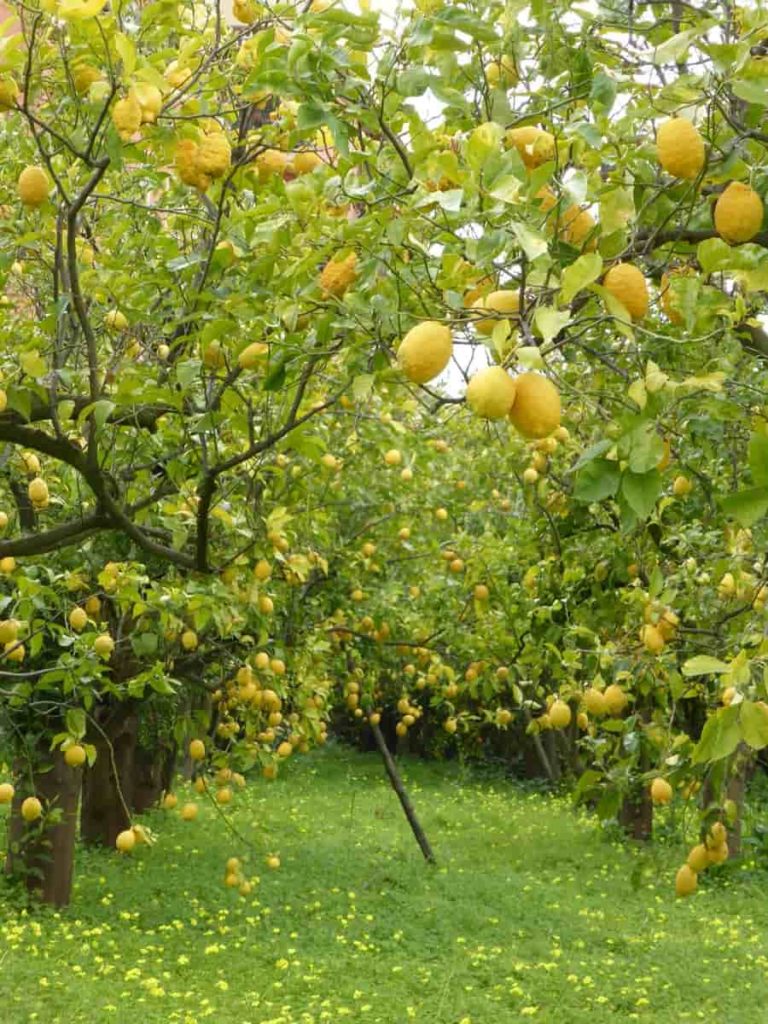High-density planting is defined as the habitat of a maximum number of plants per unit area to get maximum profit per unit of tree volume without impairing the soil fertility. It gives high yields in the early stages of the garden and makes it easy to manage. In HDP, trees are planted at close distances, leading to higher density cultivation. This technique uses small-roofed dwarf trees, which are pruned regularly during the early stages of development to keep the size of the dwarf and the canopy small.
It allows better air circulation, sunlight penetration, easier pruning, and pesticide management, which results in higher productivity at a lower cost. For maximum possible production of good quality fruits, plant density is optimal, which should be maintained to maintain the economic life of the plant. It varies greatly depending on location, cultivator, land fertility, administrative level, and economy.
These factors, in turn, influence more specific factors of density selection, such as the prevailing climate, plant strength, and longevity. The main purpose of planting high-density plants is to meet the essential production requirements by balancing the plants and productive growth without affecting the quality of the fruit. The basic principle is to use vertical and horizontal space per unit of time and maximum profit per unit of inputs and natural resources. Let’s check out a step-by-step guide to high density farming below.
Advantages of high-density planting
- Low cost per unit production
- Allow mechanization in fruit crops
- Improving fruit production and quality
- Efficient use of natural resources
- Induces precocity, increases production, and improves fruit quality
- Reduces labor costs resulting in lower production costs
- Enables mechanization of fruit crop production
- More efficient use of fertilizers, fungicides, weedicides, and pesticides
High-density planting requires canopy management that involves pruning and training, i.e., positioning organs and growth regulators in specific ways to regulate growth. It includes maintaining healthy tree growth. It also helps to increase fruit production. Agricultural machinery is required mainly from the initial to the last stage of harvesting to planting high-density plants. They are
- Earth auger that helps in making holes for planting.
- To remove weeds and soil, changing the intracultural is very useful.
- Tree pruning tools remove unwanted limbs or branches from a tree.
- Orchard sprayers are helpful for the effective use of pesticides.
- Fruit picker for harvesting fruits without loss.
The principle of HDP
- Increase in sunlight per unit area.
- To maximize the potential return per unit of input and resources.
- Land use efficiency.
- Proper vegetative balance of plants.
Components of HDP
Dwarf Scion Varieties
Dwarf scion varieties are easy to use in establishing high-density gardens if the trees are naturally small. Mango-Amrapalli, Papita-Pusa Nanha, Banana-Dwarf Cavendish, Apple – Spur varieties like Red Chief, Oregon Spur, Cherry – Compact Lambert, Meteor and North Star, Peach – Red heaven, Sapota – PKM-1, PKM-3
Use growth regulators
Use growth regulators to prolong growth, reduce vegetative growth, delay flowering, and reduce fruit fall. Plant growth regulators such as Alar, Uniconazole, Paclobutrazol, and prohexadione-calcium have been used to restrict vegetative growth. The September-November treatment effectively increased flowering and fruiting and reduced plant growth (30-35%).
Dwarf rootstocks and inter-stocks
Rootstocks are known for their profound effects on tree vigor, early condition, fruit quality, productivity, and longevity of the varieties grafted on them. Dwarfing can be due to rootstock or scion, or both.
Dwarf rootstock varieties are;
| Crop | Varieties |
| Mango | Vellaikolumban (Alphanso), Olour (Himsagar and Langra) |
| Guava | Pusa srijan, Psidium friedrichsthalianum, Aneuploid-82 |
| Citrus | Trifoliate orange, Sour orange, Citranges |
| Apple | M4, M26, MM106, M7, M9 |
| Pear | Quince |
Proper crop management methods in HDP
In HDP, adopting appropriate crop management practices such as mulching, fertilization, organic farming, Integrated Nutrient Management (INM), and Integrated Pest Management (IPM) is important for plant care and maintenance.
Training and Pruning – These are effective tools because of their effect on tree shape and size control. Overcrowding creates a serious problem for access to the garden and prevents the maximum photosynthesis, flower and fruit set, and light required for quality. Various workers have tried pruning for canopy management in high-density gardens.
The tree’s proper shape, the branches’ angle, and the distance between the limbs helps control the growth. Pruning is applied in Guava, Plum, and Fig to regulate the crop and in Mango to restore old orchards. Pruning control of tree size is limited to Grapes, Apples, and some other temperate fruits.
A step-by-step guide to high density farming
High-density planting in Guava
High-density orchard facilitates the increase in fruit production and quality. High-quality yields are obtained from densely planted orchards through proper canopy management and tree training systems. Better light distribution within a tree canopy increases the number of well-lit leaves. It also promotes the photosynthesis rate, leading to a higher yield per unit area. This planting system will revolutionize the guava industry by increasing the production capacity and reducing the production cost.
Due to its increasing demand, the need for high-density guava cultivation in India is always high. This strategy involves planting closer to the proposed site for better crop management, a smaller canopy of trees, higher yields, and better fruit quality. You can choose Allahabad Safeda, Sardar, Allahabad Surkha, Shweta, Lucknow-49, Arka Mridula, and Punjab Kiran for high-density guava production. This method of planting guava can cover 5000 plants per hectare at a spacing of 1.0×2.0 meters.
The canopy of the plants was properly arranged with regular pruning. They were at their peak in October, two months after planting. After new shoots appear, 50% of the shoots are replanted in December-January for new shoots. It achieves the desired tree canopy architecture and a strong framework. Emerging shoots are allowed to grow for 3 to 4 months before being reduced to 50%. After pruning, new shoots emerge on which flowers appear. Mulching is essential in controlling weed growth while helping water penetrate the soil.
High-density planting in Banana
- Robusta – 4400 plants / hectare (1.5 m x 1.5 m spacing) – 120 tons / hectare
- Dwarf Cavendish – 4400 plants (1.5 m x 1.5 m spacing) –100 tons / hectare
- Ney Poovan – 5120 plants per hectare (1.5 m x 1.5 m-triangle planting) is recommended, which is 16% more than 4440 plants per hectare (1.5 m x 1.5 m planting).
High-density planting is generally considered a system in which more plants are planted in a unit area than conventional planting. In Bananas, it is important to adopt maximum density to bridge the gap between actual and potential production of bananas from one unit area. In the case of Bananas, the maximum planting density is critical to bridge the gap between actual and potential yield per unit area of Banana. Adopting these has increased land-use efficiency, water, and fertilizer use efficiency, which has increased standard bananas production capacity and farm income.
High-density planting combined with drip and weekly fertilization techniques results in better input utilization efficiency than conventional methods and saves 30-40% irrigation water and 25% fertilizer. It has resulted in lower production costs, increased production, productivity, and quality of fruits. Preliminary testing of weed populations with high planting density (4440 to 6950 plants/hectare) reduced weed growth through cowpea intercropping.
In case you missed it:
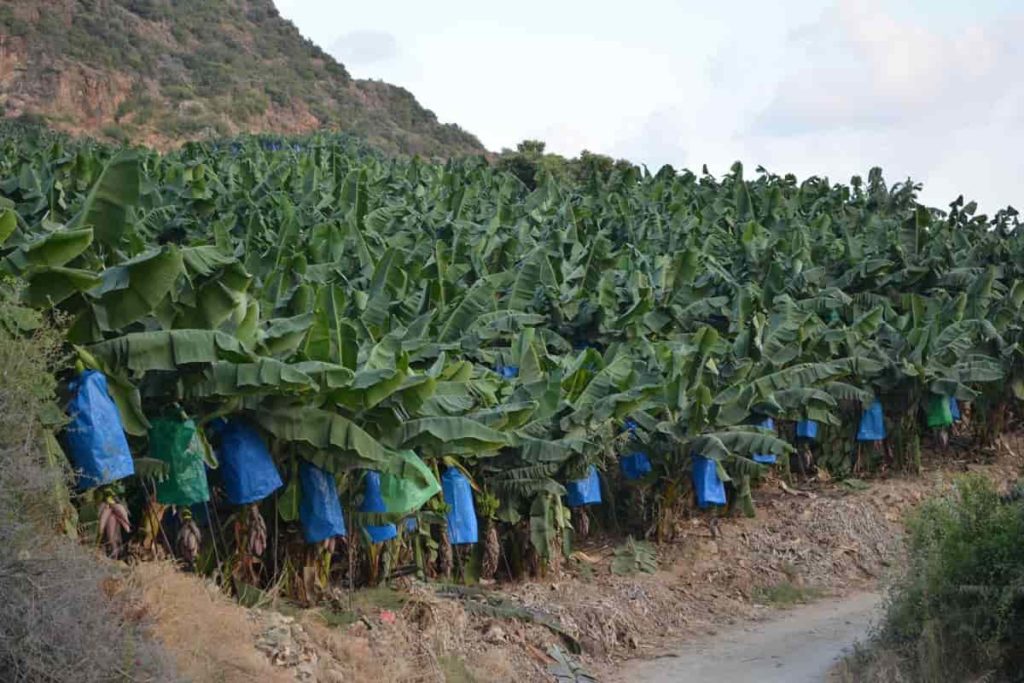
Under high-density planting, weed growth is minimized at all stages of plant growth, and cowpea intercropping has not only prevented weed growth but also improved soil fertility. Planting high-density bananas help in getting higher yields. In addition to high-density planting, cowpea intercrop, timely irrigation, and fertilization can dramatically increase the production of Robusta bananas without adversely affecting finger size and shape.
The HDP system requires fertilizers of different planting densities, with three and four suckers per pit at a spacing of 1.8 x3.6 meters. The NPK had three levels. 50, 75, and 100% of the recommended doses. When planting in parallel rows, the density of more plants increased the relative humidity, kept the moisture off the leaves longer, and thus increased the incidence.
High-density planting in Lemon
High-density plantings have been experimented with in the Advanced Citrus Production System (ACPS) worldwide to increase water, fertilizer, and light efficiency and maximize yield per acre. Hilly areas are planted against slopes in mountainous areas, and it is possible to plant more density on such lands as more air space is available than on flat lands.
Planting more or more densely planted lemon trees takes some care of the surrounding environment for producing healthy fruits. Sunlight is an important component in the production of citrus fruits. Planting high-density gardens can limit the amount of light for each tree. Once the young trees have matured, canopies should be cut to provide equal light access to the crown and between each tree.
There are two types of high-density plantings in orchards. These are twin-row and a standard layout. Twin row high-density trees are planted at 952 trees per hectare and standard layout high-density trees are planted at 600 trees per hectare (5.2m × 3.2m).
In case you missed it: How to Grow Lemon Tree from Seed: A Step-by-Step Guide for Beginners
High-density single row layout at 600 trees/hectare;
- 5.2m × 3.2m spacing
- Mature tree; year 10, canopy diameter 3.3 meters, tractor access 1.9 meters, and canopy surface cover 63%
High-density twin row layout at 952 Tree/hectare;
- Mature tree; year 9, canopy diameter (two trees) 5.4 meters, tractor access 1.9 meters, and canopy surface cover 74%.
High-density planting in Mango
HDP makes maximum use of land to achieve high crop yields in the early periods of the orchard. High-Density Planting (HDP) (5 x 5 meters) aims to maximize land use and yields in the garden’s early stages. And with ease of management, this system guarantees the adoption of important technologies like early pruning in the early years so that the plants have the desired architecture—proper management in favor of starting and differentiating fruit buds to stop plant growth during September.
Furthermore, adopting a drip irrigation system to compensate for the loss of moisture through evaporation and the provision of adequate nutrients through fertilization techniques is essential to achieve higher yields with quality fruits. Adopting a drip irrigation system to meet the moisture deficit and provide adequate nutrients through fertilization is essential to achieving higher yields with standard fruits.
In case you missed it: Organic Mango Farming, Cultivation Practices
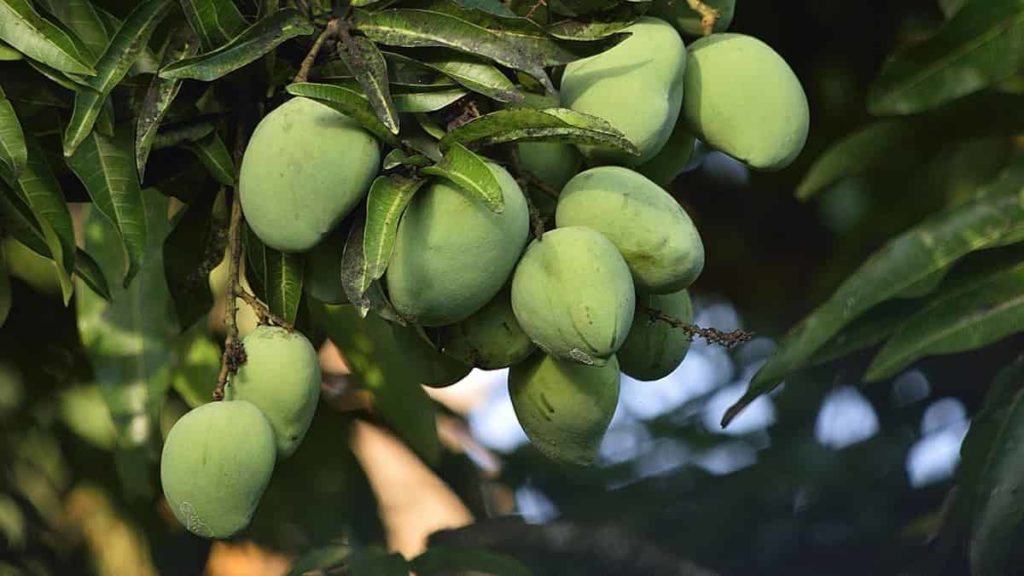
It prefers a soil pH of 6.5 to 7.5. Under HDP, Mango is planted at three × 2 meters which can grow 674 plants per acre. Before digging the pit, the pit should be marked at three × 2 meters, and pits of 1 × 1 × 1 meters should be dug at the marked places. Alternatively, a trench one meter deep, one meter deep, and one meter wide can be made for every three meters. The pits must be allowed to weather for a few weeks before filling the media.
Benefits of high-density plantation in Mangoes
- Increases productivity by 2-3 times.
- Reduces water usage by up to 50%
- Increases the amount of fertilizer used by plants when fertilization is practiced.
High-density planting in Apples
Successful apple tree management in any high-density planting system depends on balancing plant growth and fruit. Pruning and managing crop loads along with fertilizer and irrigation are the basic management tools used to balance plant growth and harvest throughout the life of orchards. With increasing pressure on land and declining average land reserves, shifting from a low-density planting system to a high-density has become a matter of time, especially in horticulture. High-density trees produce more unusual, heavier yields and better-quality fruit.
In case you missed it: Organic Apple Farming, Cultivation Practices
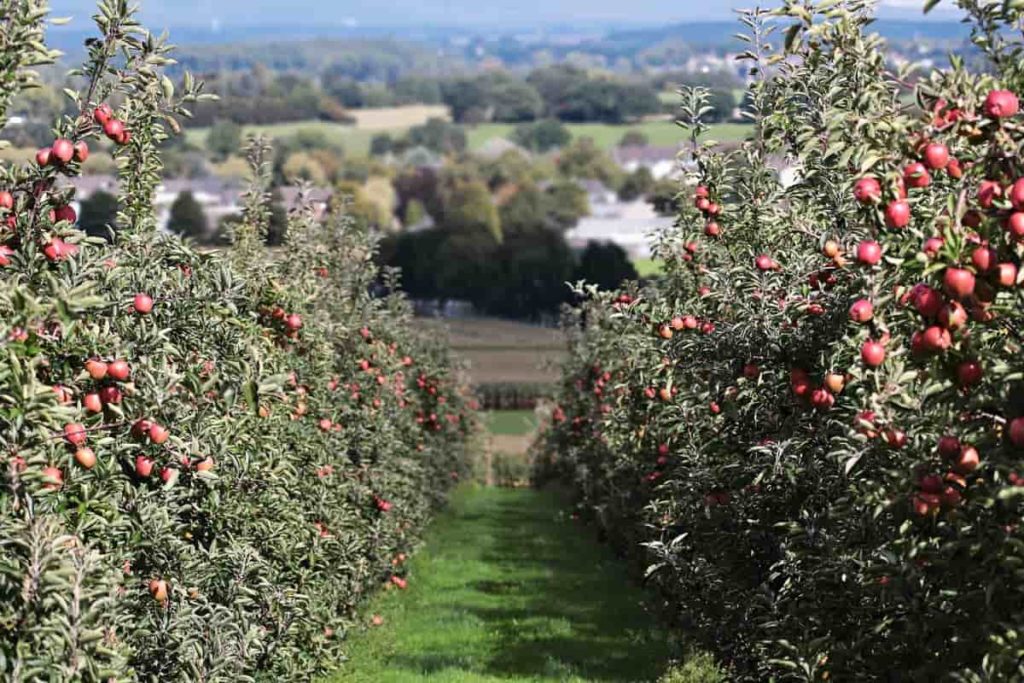
Traditional planting systems have a long lifespan, require labor, and produce low-quality fruits. While high density is easily manageable, it can produce more with better quality fruit and higher profit/unit area. But it cannot be applied to steep, non-fertile, shallow, and drought-prone areas. There are 4 types of high-density planting which are:
- Low (less than 250 plants per hectare)
- Moderate (250-500 plants / hectare)
- High (500-1250 plants / hectare)
- Ultra-high density (more than 1250 plants / hectare)
With the increase in planting density, the yield may increase, but beyond the threshold density, the quality deteriorates and cannot be profitable in terms of economic profit. Trees should have a maximum number of fruits bearing branches and a minimum number of structural branches.
The key to successful high-density planting depends on the control of tree size. The following methods can be adopted.
- Use of size control rootstocks
- Use of spur-type scions
- Pruning and training methods to induce dwarfing and spreading habits of the tree
- Mechanical tools such as bending a branch to control the size
- Use of chemicals
- The easiest method to control this is to use a clonal rootstock that controls the size.
Standard apple trees are planted at a distance of 7.5 x 7.5 meters with a planting density of about 178 trees per hectare, and standard apple trees with a density of 400 plants are planted at a distance of 5.0 x 5.0 meters on seedling rootstocks. The average productivity of these gardens is about 6 to 8 MT/hectare, which is far less than the productivity of high-density gardens (40-60 MT/hectare).
In high-density planting, up to 5,333 apple trees per hectare can be planted on clonal rootstocks to increase production per unit area basis and improve production quality. High-density gardening can be done on flat and fertile soils using dwarf / semi-dwarf clonal rootstocks with definite irrigation, trained in modern canopy management methods such as vertical axis, slender spindle, and long spindle.
Canopy management is paramount in controlling tree vigor and planting high-density plants for standard fruit harvesting. Training and pruning are two important gardening methods. The training aims to help the tree architecture’s main branches increase access to sunlight, plant density, and productivity.
High-density planting in Papaya
A spacing of 1.2 x 1.2 meters for cv. Pusha Nanha variety has been adopted for high-density plants with 6,400 plants per hectare. For high-density papaya planting, a 1-1.5 cubic foot pit should be dug at 1.2 x 1.2 meters and filled with 30-40 kg FYM 25 grams aldrin 5% dust should be added to the pits and filled with topsoil. Dwarf varieties of Papaya such as Pusa Dwarf, Pusa Nanha, Red Lady 786, and Ranchi make it possible to grow Papaya under HDP plantation.
In case you missed it: Top 20 Steps to Boost Papaya Yield: How to Increase Fruit Size, and Production
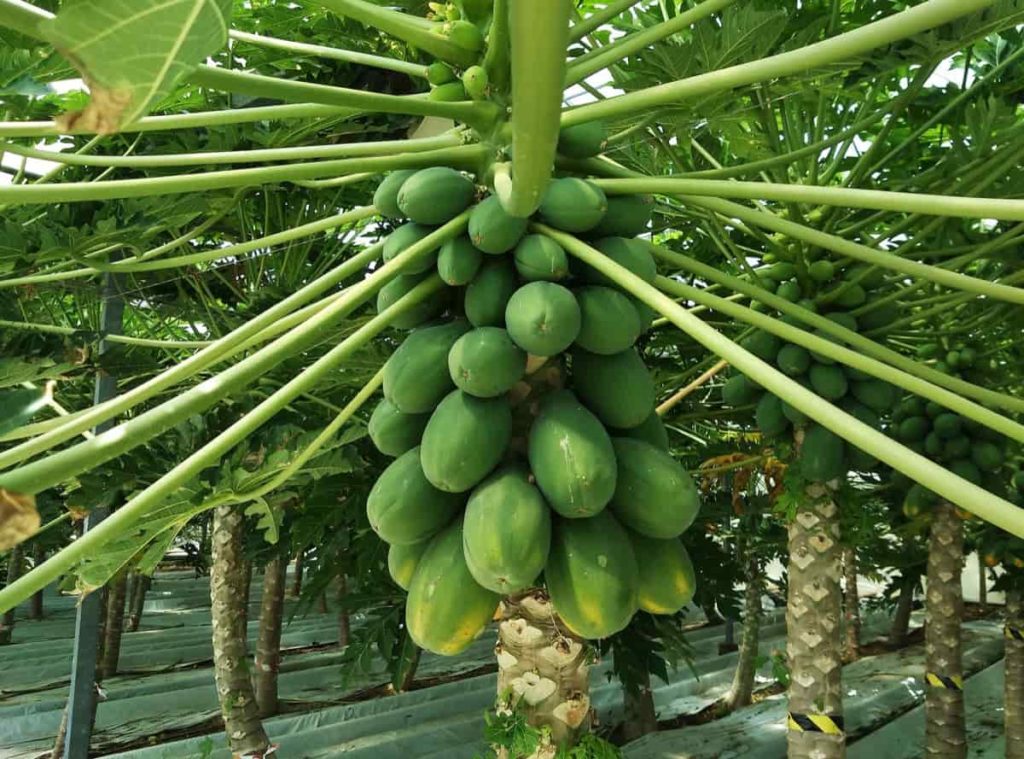
High-density planting in Litchi
High-density planting techniques is an innovative method of litchi cultivation that involves dense planting of lychee trees, converting small or dwarf trees to better light prevention and distribution and ease of mechanized field operation. Umbrellas are allowed. Irrigation and fertigation are controlled automatically.
Such a system cultivates a premature crop and requires high and regular production of good quality fruits and low wages to meet the ever-increasing production costs. Although a small canopy with a large number of well-lit leaves is useful in photosynthesis, it is very low in light resistance, resulting in a low yield per hectare. Light retention can be improved by increasing tree density.
Maximum tree density is the density level required to maximize light distribution and facilitate interference, leading to higher photosynthesis. It results in maximum yield per hectare. Maximum light retention is a factor in plant shape, planting density, tree layout, and leaf response to light for photosynthesis. Maximum light intrusion can be defined as the level of light above or below prevented by a garden system, which will reduce economic productivity.
Depending on the planting system, the density of trees under Litchi in different high-density planting systems is at least 400-700 plants per hectare. Under a high-density system, litchi plants begin to bear fruit after 4-5 years. These orchards have a high number of seedlings per unit area; therefore, the gardens become economical before planting normal plants.
Light retention and distribution are also improved, thus improving the quality of the fruit. Increased yields, quicker and higher profits, lower production costs, and improved fruit quality result in higher orchard profits and provide a better competitive advantage to local litchi growers. An estimated 14-16 tons per hectare yield can be obtained from a high-density litchi planting if a complete package for HDP is adopted.
High-density planting in Pineapple
Pineapple is recommended for high-density cultivation for commercial purposes. Planting density 63,400 plants per hectare. (22.5 x 60 x 75 cm) is ideal for subtropical and mildly humid conditions, while the plant density is 53,300 plants per hectare at 25 cm for hot and humid conditions.
The yield of 70-105 tons per hectare can be achieved under high-density planting, increase in yield/unit area is 45-85 tons/hectare. In the overall analysis, plant-to-plant spacing of approximately 22.5 to 25.0 cm and row-to-row spacing of about 45 to 60 cm are ideal.
In case you missed it: Organic Pineapple Cultivation – Farming In India
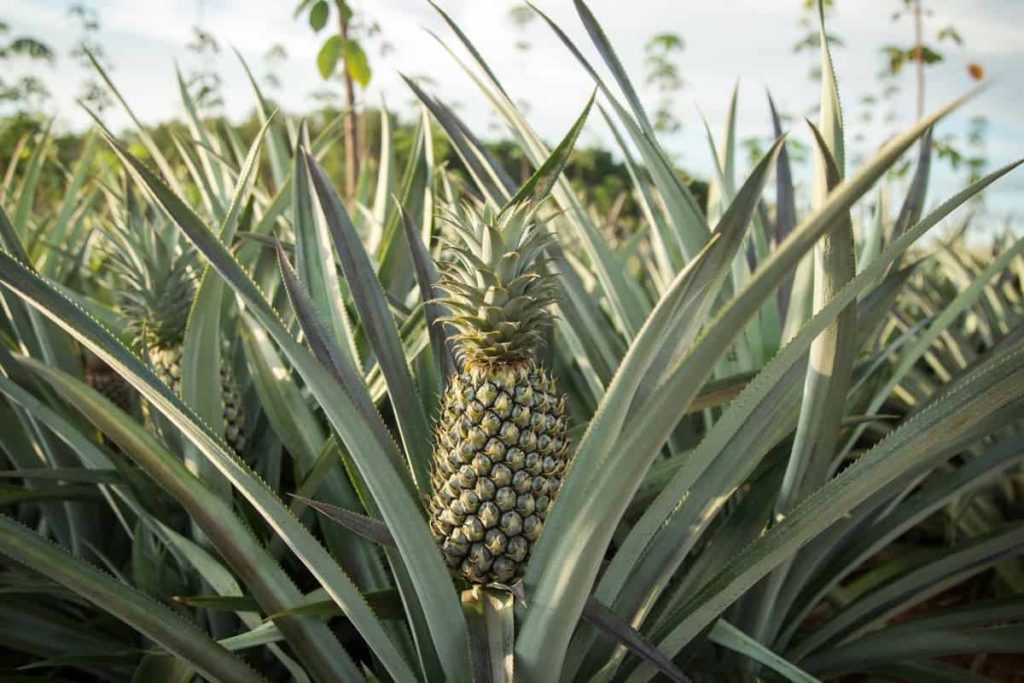
Conclusion
High-density planting means increasing the planting of the same species of plants per unit area without affecting the quality of the fruit. It increases production and returns per unit area, is environmentally friendly, has efficient land use, and efficient use of resources like light, water and fertilizers, and pesticides. HDP maintains a balance between plant and reproductive development without affecting plant health. Therefore, it can be concluded that planting high-density plants can increase the productivity of fruit crops.
- How to Make Houseplants Bushy: Effective Tips and Ideas
- Innovative Strategies for Boosting Coconut Pollination and Yield
- Pollination Strategies for Maximum Pumpkin Yield
- The Complete Guide to Chicken Fattening: Strategies for Maximum Growth
- Natural Solutions for Tulip Problems: 100% Effective Remedies for Leaf and Bulb-Related Issues
- Revolutionizing Citrus Preservation: Towards a Healthier, Greener Future
- Natural Solutions for Peony Leaf and Flower Problems: 100% Effective Remedies
- Maximizing Profits with Avocado Contract Farming in India: A Comprehensive Guide
- Natural Solutions for Hydrangea Problems: 100% Effective Remedies for Leaf and Flowers
- The Ultimate Guide to Choosing the Perfect Foliage Friend: Bringing Life Indoors
- From Sunlight to Sustainability: 15 Ways to Use Solar Technology in Agriculture
- The Ultimate Guide to Dong Tao Chicken: Exploring from History to Raising
- The Eco-Friendly Makeover: How to Convert Your Unused Swimming Pool into a Fish Pond
- Mastering the Art of Delaware Chicken Farming: Essentials for Healthy Backyard Flocks
- 20 Best Homemade Fertilizers for Money Plant: DIY Recipes and Application Methods
- How to Craft a Comprehensive Free-Range Chicken Farming Business Plan
- Brighten Your Flock: Raising Easter Egger Chickens for Beauty and Bounty
- How to Optimize Your Poultry Egg Farm Business Plan with These Strategies
- Subsidy for Spirulina Cultivation: How Indian Government Schemes Encouraging Spirulina Farmers
- Ultimate Guide to Raising Dominique Chickens: Breeding, Feeding, Egg-Production, and Care
- Mastering the Art of Raising Jersey Giant Chickens: Care, Feeding, and More
- Ultimate Guide to Raising Legbar Chickens: Breeding, Farming Practices, Diet, Egg-Production
- How to Raise Welsummer Chickens: A Comprehensive Guide for Beginners
- How to Protect Indoor Plants in Winter: A Comprehensive Guide
- Ultimate Guide to Grow Bag Gardening: Tips, Tricks, and Planting Ideas for Urban Gardeners
- Guide to Lotus Cultivation: How to Propagate, Plant, Grow, Care, Cost, and Profit
- Agriculture Drone Subsidy Scheme: Government Kisan Subsidy, License, and How to Apply Online
- Ultimate Guide to Raising Araucana Chickens: Breed Profile, Farming Economics, Diet, and Care
- Bringing Hydroponics to Classroom: Importance, Benefits of Learning for School Students
- Ultimate Guide to Raising Polish Chickens: Breed Profile, Farming Economics, Diet, and Care
- Ultimate Guide to Raising Australorp Chickens: Profile, Farming Economics, Egg Production, Diet, and Care
- Silkie Chicken Farming: Raising Practices, Varieties, Egg Production, Diet, and Care
- Sussex Chicken Farming: Raising Practices, Varieties, Egg Production, Diet and Care
- Homemade Feed Formulations for Livestock: Discover Cost-effective Starter to Finisher Feed Recipes
- 20 Best Pig Weight Gain Supplements: Top Swine Weight Gain Formulas
- Ultimate Guide to Elderberry Farming: Propagation, Planting, Yield, Cost, and Profit
